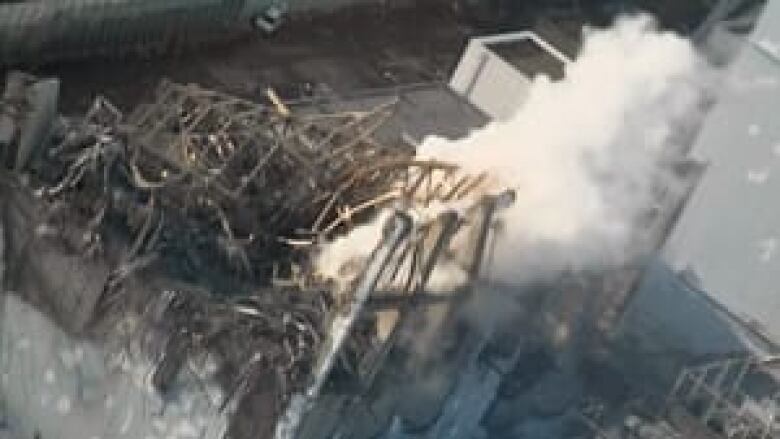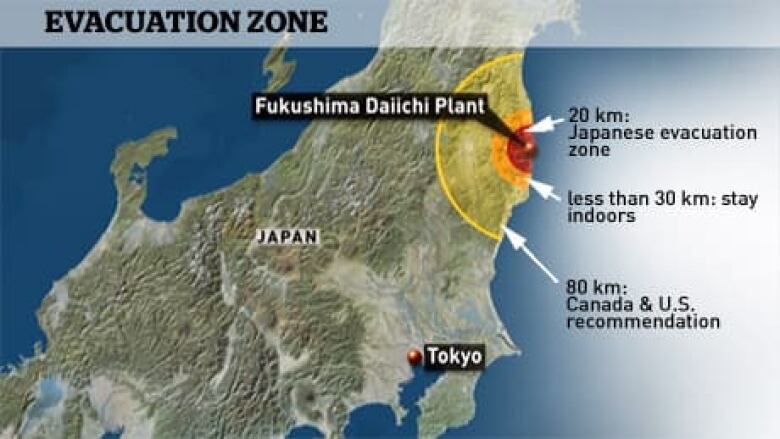New power line to Japan nuclear plant readied
External cable laid to restore function to cooling system

Latest
- Helicopters, fire trucks used to douse reactor
- Officials hope new power line will revive electric-powered pumps
- Death toll from earthquake, tsunami hits 5,300
Japanese engineers have succeeded in laying a power cable to the No. 2 reactor of the Fukushima Daiichinuclear power plant, the International Atomic Energy Agency says, raising hopes that electric water pumps could soon restore cooling.
"They plan to reconnect power to Unit 2 once the spraying of water on the Unit 3 reactor building is completed," the IAEA said in a statement Thursday.
The external grid power line is intended to restart electric pumps for cooling the reactor, which lost its main and backup power supplies following the earthquake and tsunami, causing dangerous overheating of the reactors and spent fuel rod pools.
Tokyo Electric Power Co., operator of the plant,said it hopes to activate the cooling system of the No. 2 reactor as early as Friday night after restoring power to the system, Japan's state broadcaster NHK reported.
The utility said the No. 2 unit seems to have suffered less damage to its electrical equipment than the other reactors at the plant, but connecting the power line could be hampered by the radiation threat to workers who will need to approach the reactor.
Three reactors have had at least partial meltdowns at the nuclear plant, where wisps of white steam rose from the stricken units Friday morning.
But Japanese and U.S. officials believe a greater danger exists in the pools used to store spent nuclear fuel: Fuel rods in one pool were believed to be at least partially exposed, if not dry, and others were in danger. Without water, the rods could heat up and spew radiation widely.
Japanese authorities raced to cool thereactors atthe damaged nuclear complex Thursday, using helicopters and large-capacity trucks to spray water.

The dousing was aimed at coolingdown thereactorsand adding water tothe pools wherespent fuel rods are stored, said Noriyuki Shikata, a spokesperson for Japanese Prime Minister Naoto Kan.
Large trucks and a water cannon were also sent to the scene to join efforts to cool the reactor from the ground, broadcaster NHK reported.
The Defence Ministry did not confirm whether the water reached the storage pools at Unit 3, but NHK reported the water did reach the inside of the building that houses the pool. U.S. officials, meanwhile, said Unit 4 also was seriously at risk.
OnFriday, Japan's military said it did not plan further helicopter airdrops of water on the plant.
Gregory Jaczko, chairmanof the U.S. Nuclear Regulatory Commission, said at a congressional hearing in Washington on Thursday that all the water was gone from that unit's spent fuel pool. Jaczko said anyone who gets close to the plant could face potentially lethal doses of radiation.
The plant's owner, Tokyo Electric Power Co., saidThursday it believed the rods in that pool were covered with water, but an official with Japan's nuclear safety agency later expressed skepticism about that and moved closer to the U.S. position.
[IMAGEGALLERY galleryid=191 size=small]
"Considering the amount of radiation released in the area, the fuel rods are more likely to be exposed than to be covered," Yuichi Sato said.
Japanese officials have ordered anyone living within 20 kilometres of the plant to leave the area, while those living within 30 kilometres have been urged to seal themselves indoors.
LIVE BLOG:
Disaster in Japan
On Friday, Japan's top government spokesman said that Tokyo is willing to accept U.S. help in dealing with the country's nuclear crisis and is discussing the matter with Washington.
"We are co-ordinating with the U.S. government as to what the U.S. can provide and what people really need," government spokesman Yukio Edano said.
"We have repeatedly asked for specific support, and indeed, they are responding to that," Edano said.
Japan's Science Ministry said Thursday that radiation levels of up to 0.17 millisieverts per hour were detected about 30 kilometres northwest of the Fukushima Daiichi plant, according to state broadcaster NHK.
Exposure to those levels for six hours would result in absorption of the maximum level considered safe for one year, the report said.
The ministry measured radiation Thursday at 28 locations, in areas 20 to 60 kilometres from the plant, and observed radiation levels of 0.0183 to 0.0011 millisieverts per hour at most of the areas. The ministry said those levels were higher than normal but not an immediate health threat.
A city partially within the 20-kilometre evacuation zone, Minami Soma, was preparing to move 30,000 people out of the prefecture. Shelters within the prefecture were already full.
Thousands of people have poured out of the area surrounding the plant.
"About 600 people, many of whom lived in the immediate vicinity of the reactors, made their way here,"CBC's Curt Petrovich said from an evacuation centre in Niigata, about 170 kilometres west of the Fukushima plant.
"They are all over the floor on neatly ordered blankets. There are men, women, children, babies," he said. "Many people are here with just the clothes on their backs, and many people are afraid of what lies ahead."
Canadian officials had been following the Japanese guidelines, but on Wednesday they advisedCanadians to avoid all travel within 80 kilometres of the stricken plant.
Shikatasaid the Japanese government thinks the current evacuation zone is appropriate and has no plans toexpand it.
[IMAGEGALLERY galleryid=189 size=small]
"We are taking precautionary measures in terms of protecting the safety of our citizens," he said.
Many countries are encouraging people to avoid allnon-essential travel to Japan.
Countries including Britain, the United States, South Korea, Australia and Germany have advised their citizens to leave Japan because of radiation from damaged nuclear reactors.
WhileAmerican officialshave been careful not to directly criticize Japan's response, they have made clear it's difficult to determine what is going on.
"It's a very fluid and indeed it's a very confused situation," U.S. Deputy Energy Secretary Daniel Poneman told reporters Wednesday.
Aftershocks, rising death toll
Nearly a week after the disaster, aftershocks continued to rattle parts of Japan.
On Thursday, a 5.9-magnitude quake was recorded off the coast, about 135 kilometres southeast of Fukushima,CBC meteorologist Johanna Wagstaffe said.
More than 5,300 people are officially listed as dead, but officials believe the toll will climb to well over 10,000.
The United Nations office for humanitarian affairs said the aftershocks, bitter winds, cold temperatures and mountains of debris have slowed search and rescue efforts.
Aid agencies are trying to deliver assistance to the 430,000 people living in evacuation centres, but fuel, food, water and medical supplies are running low in some areas, the UN office said.
Doctors deployed in the affected region told the UN that many evacuees have diarrhea and other illnesses caused by the freezing weather and the lack of clean water and sanitation facilities.

With files from The Associated Press












_(720p).jpg)


 OFFICIAL HD MUSIC VIDEO.jpg)
.jpg)



























































































